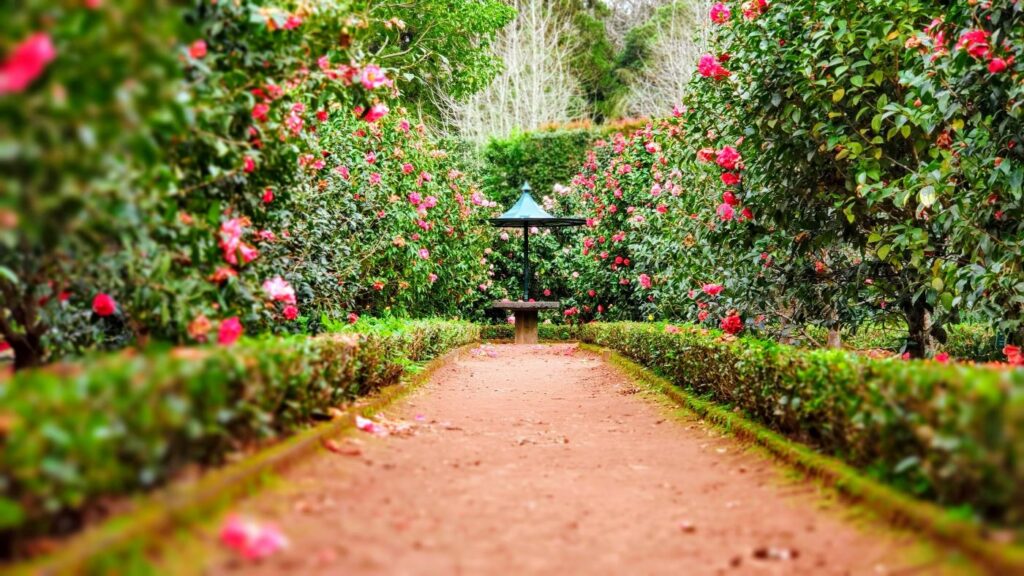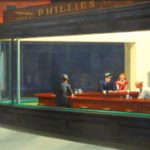For seven years, I have been watering and weeding my family’s garden plot, alongside many other plots in our local park. The woman whose plot is next to ours grows poppies that flare out and fall away each year. The first summer I started gardening in my plot, I shyly waited for her to offer me a flower as my family and I offered her tomatoes and berries—but no luck.
Yet my garden neighbor does offer occasional conversation through polite questions about my school, family, and summer schedule. We trade stories about weeding and weather, compliments about flower bushes and new fruit plants. As we’ve worked our square plots side by side, I’ve shared snippets of my faith and my passion for Christian education with my neighbor—in addition to snippets of our produce.
My garden neighbors and I occupy a place not altogether unlike the sociologist Ray Oldenburg’s “third place.” With home first and work second, Oldenburg holds that the third place—a public place of “neutral ground” for interaction—could function as an antidote to the increasing atomization encouraged by modernity and the “automobile suburbs.” People of different occupations and social strata may enter as equals into these public places of refreshment—local coffee shops, restaurants, parks, diners. By offering a politically neutral ground for strangers to convene, third places can provide a space of common ground—of good will, relaxation, and, in the long run, social and civic renewal.
But activities like gardening—what Josef Pieper has called “active leisure”—offer even more than third places can. Active leisure, too, creates a meeting ground for people of any background, but active leisure requires and is rooted in a true vision of our condition: as creatures responsible for stewarding what’s been given to us.
Start your day with Public Discourse
Sign up and get our daily essays sent straight to your inbox.Third Places
What, exactly, is so significant about third places? They provide an “informal public life,” Oldenburg maintains, without which individualized means of satisfaction and stress relief displace healthier, more social ways of enjoying life. Oldenberg saw in the 1980s that the structure of shared experience beyond that offered by family, job, and passive consumerism is small and dwindling. The essential group experience is being replaced by the exaggerated self-consciousness of individuals. American lifestyles, for all the material acquisition and the seeking after comforts and pleasures, are plagued by boredom, loneliness, alienation, and a high price tag.
These trends that Oldenburg identifies have only grown starker today. Covid-19 created unprecedented levels of alienation. Since the pandemic, many Americans (especially young adults) continue to feel lonely, spending time online instead of socializing with others.
Oldenburg turns to third places as an antidote to these trends that were already afoot in the 1980s, and writers today continue to heed his arguments. In Oldenburg’s schema, informal memberships at local places promise to produce local knowledge, shared experience, and, ideally, the “participatory entertainment” created by conversation with unique characters that may together create friendship. There is much to appreciate in Oldenburg’s observations about the social goods of third places.
Active Leisure
Yet there are other gathering places and activities that could strengthen social ties even more powerfully. Gardening demands a certain amount of labor that a bar doesn’t require of its customers, for the garden’s central endeavor is not relaxation but loving and patient work. Thus, a garden promises less entertainment and amusement than a third place does, demanding instead focus, effort, and attention. Because it’s not passive or consumptive, it is less conducive to the conversation and dialogue that a bar or diner might allow. A garden, therefore, is not a place for discussion and debate where unexpected consensus might emerge.
But one look at social media suggests that mere cultivation of public conversation cannot create a spirit of friendship. The free-speech optimists who think open conversation is sufficient for civic cohesion rely on a utopian view of human nature: we need only rub elbows at the pub and talk things over, and our issues will eventually resolve themselves.
Spontaneous agreement and goodwill, in other words, are unlikely to emerge by convening at third places. Today’s local establishments—many of which donned rainbow flags and signs declaring that “hate has no place here” last month—indicate that many modern commercial places by themselves are insufficient to create common ground. The ground of the garden poses a different possibility for connection, one that compensates for some of the deficiencies of third places. At shared gardens, neighbors connect through a shared project. Fellow gardeners enjoy the increasingly neglected endeavor of working the ground.
The ground of the garden poses a different possibility for connection, one that compensates for some of the deficiencies of third places. At shared gardens, neighbors connect through a shared project. Fellow gardeners enjoy the increasingly neglected endeavor of working the ground.
The garden thus reminds human beings of their rightful place in the cosmos and the core truths about their condition. Cultivating land recalls Eden to our minds—as well as our distance from it. Even in an amateur’s plot, the gardener must use tenderness, patience, and sweat (a famous mark of the Fall) to bring stems from seeds and soil. Planting, watering, weeding, and finally gathering and sharing blackberries recall the range of human experience: both the pain of man’s fallen toil and the harmonious, loving work of Eden.
Because gardening retains this shadow of Eden, it is not, like much of the work of our “second places,” frenzied work. Rather, it is marked by the affection Josef Pieper describes in Leisure: the Basis of Culture, a “love that certainly brings a particular freshness and readiness to work along with it, but that no one with the least experience could conceivably confuse with the tense activity of the fanatical ‘worker.’” Pieper connects this work sustained by love with “active leisure,” the concern of his book. The work of active leisure is a “cheerful affirmation” of one’s own “being, his acquiescence in the world and in God.” Loving work thus acknowledges our place in creation, thereby implicitly acknowledging our Creator himself.
As such, gardening can create a place where neighborliness and love may be practiced by people who would otherwise rarely see each other. Stewarding a shared good side by side recalls the original purpose God mandated for his creation and nods to the God above creation in a way that talking over drinks—however fun or relaxing it may be—cannot. Active leisure such as gardening is also riper for true fellowship than local hangouts are: joint endeavors create deeper, more lasting bonds because they remind us of our need for one another.
Stewardship extends beyond the garden. The garden plot is only one example of active leisure and stewardship: through the work of homemaking, parenting, educating, and all variety of creative endeavors, places such as the home, the kitchen, the classroom, and the art studio can convene strangers and offer a “cheerful affirmation” of human beings’ place in the world. Like gardening, these endeavors involve the patient but often painful work of tending. And like my family’s garden plot, all of them allow—and to some extent require—the development of neighborliness.
The garden plot is only one example of active leisure and stewardship: through the work of homemaking, parenting, educating, and all variety of creative endeavors, places such as the home, the kitchen, the classroom, and the art studio can convene strangers and offer a “cheerful affirmation” of human beings’ place in the world.
Stewarding Creation
Places of active leisure—formative endeavors that involve stewarding God’s creation—provide tangible opportunities for civic renewal where third places falter. Third places promote passivity, while active leisure, by definition, demands activity. Third places hold potential for common ground, while the active leisure of stewardship necessitates it. For stewardship requires true community. Wendell Berry considers true community in his essay “The Loss of the Future:”
We must realize that a community is not merely a condition of physical proximity, no matter how admirable the layout of the shopping center and the streets, no matter if we demolish the horizontal slums and replace them with vertical ones. A community is the mental and spiritual condition of knowing that the place is shared, and that the people who share the place define and limit the possibilities of each other’s lives. It is the knowledge that people have of each other, their concern for each other, their trust in each other, the freedom with which they come and go among themselves.
Berry shuns the notion that shared physical space is enough to facilitate community; instead, he indicates, we must acknowledge shared mental and spiritual conditions of dependence. To live and work in community—and to attempt the “cheerful affirmation” that is Pieper’s active leisure—is to be bound, implicated, tied up with one another. As one of Berry’s characters says, echoing the New Testament, “The way we are, we are members of each other . . . the difference ain’t in who is a member and who is not, but in who knows it and who don’t.” The ground of the garden plot, like that of the classroom or studio, impresses upon those who share it that we “define and limit” each other.
Creation’s rhythms also limit us and our endeavors, as any gardening teaches—rain, sunlight, and time shape our scope of action. Our neighbors limit us, as the local park’s plots especially teach: we share not only space but a common spigot, for example. We are affected by each other’s choices of fertilizer and diligence in weeding. We are affected, too, by each other’s success: this summer, a stray blackberry branch has crossed into my neighbor’s plot. My garden—and its joys—enriches and limits the gardens of others.
If civic renewal is to come, it will depend on our recognition of certain truths, one of them being our own essential dependence. As creatures, we have always been dependent on one another and the places we inhabit. Even before the Fall, it was “not good for man to be alone,” but he required a helper to work the ground and live as God had called him.
While our lifestyles of atomization—what Oldenburg termed “material acquisition and the seeking after comforts and pleasures”—aim to mask this essential dependence, they in fact reveal it. Each of us felt during the pandemic’s alienation that it is not good for us to be alone. We were not made to stare at screens, or to spend our days in ceaseless conference calls, or even to relax in public places and make friendly chatter with our neighbors (though all these things have their places). Rather we were made to work and rest—caring for this place and its people as we partake in active leisure—with joy, together.













